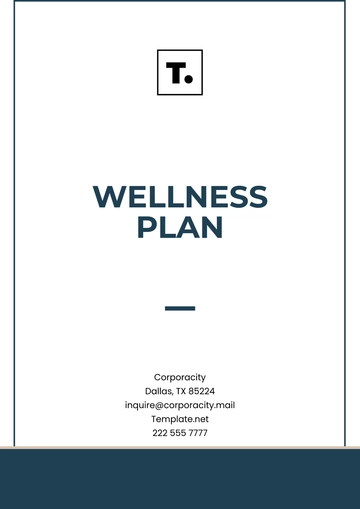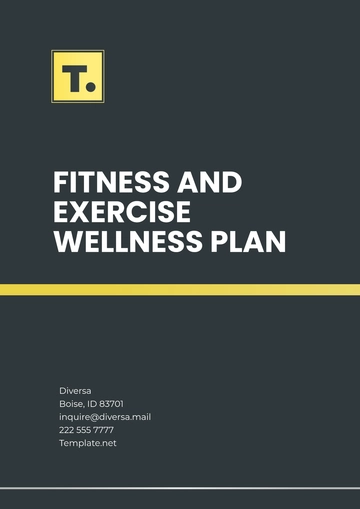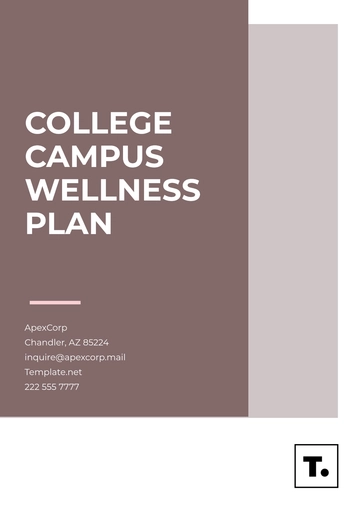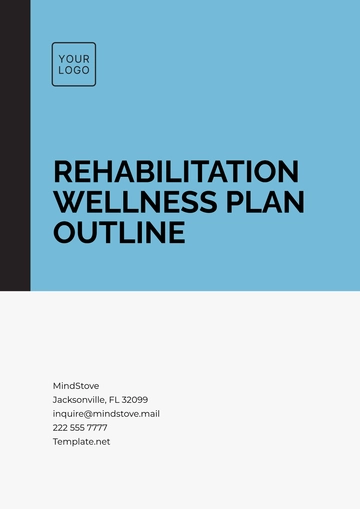Free Chiropractic Clinic Exercise & Wellness Plan
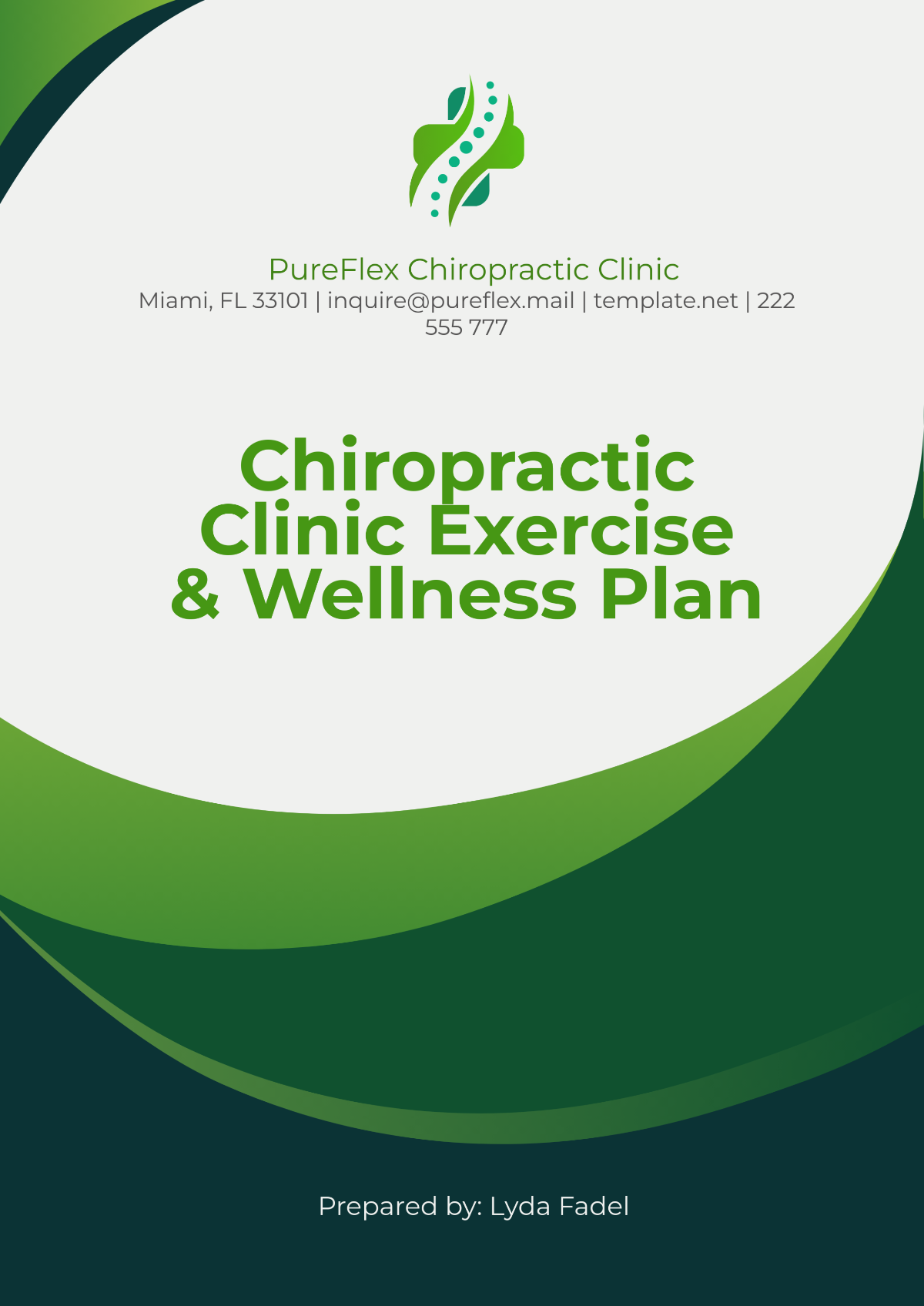
I. Introduction
A. Overview of Plan Purpose
[Your Company Name]'s Chiropractic Clinic Exercise & Wellness Plan is designed to work in conjunction with chiropractic care to address musculoskeletal issues, improve overall well-being, and support long-term health. The focus is on strengthening the muscles that support the spine, increasing flexibility, and correcting postural imbalances. By integrating exercise with chiropractic adjustments, this plan aims to reduce pain, prevent future injuries, and optimize spinal health for better daily function.
B. Patient’s Medical History and Current Health Status
[Patient Name], a 42-year-old male, presents with chronic lower back pain that has been persistent for the past two years, exacerbated by prolonged sitting and lifting. He reports occasional radiating pain into his left leg, especially after physical activity or periods of sitting. Medical imaging has shown mild disc degeneration at L4-L5, which contributes to his discomfort. Despite chiropractic adjustments, [Patient Name] experiences intermittent flare-ups, requiring a comprehensive exercise and wellness plan to enhance recovery and improve his quality of life.
C. Chiropractic Goals
The primary goals for chiropractic care are to alleviate lower back pain and improve spinal alignment, thereby reducing the frequency and intensity of flare-ups. Additionally, the plan seeks to address muscle imbalances that contribute to his discomfort. Chiropractic treatment will aim to restore proper joint function, while exercises and wellness strategies will be integrated to help maintain alignment and prevent recurrence of symptoms.
D. Expected Outcomes
By the end of the plan, we expect [Patient Name] to experience a reduction in pain, improving from a 6/10 to a 2/10 on the pain scale during daily activities. His posture will improve with less forward head tilt and better lumbar alignment, contributing to less strain on his spine. Strength and flexibility improvements are also expected, particularly in his core, hips, and lower body, which will help him regain functional movement and confidence in physical activities.
II. Evaluation
A. Postural Assessment
Upon evaluation, [Patient Name]’s posture reveals mild forward head posture and an exaggerated lumbar curve, which places additional stress on his lower back and hips. These misalignments have likely contributed to his chronic pain. His pelvic tilt and muscle imbalances, including tight hip flexors and weak glutes, need to be addressed to promote better alignment and reduce strain. The postural assessment will guide the corrective exercises in the plan, with a focus on neutral spine alignment and muscular symmetry.
B. Functional Movement Screening
[Patient Name]’s range of motion is limited, particularly in lumbar flexion and hip extension. He struggles to bend forward without pain, and his left hip shows tightness that restricts his movement. His strength assessments reveal moderate weakness in the abdominal muscles, which are crucial for spinal support, and some instability in single-leg balance tests. Improving flexibility, strength, and mobility in these areas will be a key focus of the plan to restore functional movement patterns.
Range of Motion (ROM) Testing | Limited lumbar flexion and reduced hip extension are contributing to [Patient Name]’s pain. We will focus on improving these movements through stretching and mobility exercises. |
Strength and Endurance Assessment | Core and lower body strength will be targeted in this plan, as [Patient Name]’s weak abdominal and glute muscles are contributing to poor posture and discomfort. |
Balance and Coordination Evaluation | [Patient Name]’s slight instability during balance tests will be addressed with exercises aimed at improving proprioception and coordination, reducing the risk of falls or further injury. |
C. Pain Assessment
[Patient Name]’s pain is primarily located in the lower back, with occasional radiating pain down his left leg, especially after physical exertion or long periods of sitting. The pain level fluctuates but is consistently moderate (6/10) with flare-ups, and it worsens with certain movements like bending or twisting. The goal is to reduce pain to a manageable level (2/10) through a combination of chiropractic adjustments, exercise, and lifestyle modifications. Identifying and avoiding pain triggers, such as improper lifting techniques and prolonged sitting, will be an integral part of this plan.
D. Flexibility and Mobility Assessment
[Patient Name]’s flexibility is limited in key areas such as the hamstrings, hip flexors, and lumbar spine. These restrictions not only contribute to pain but also limit his ability to perform daily activities such as bending, lifting, or walking. The plan will focus on enhancing flexibility in these areas through targeted stretching exercises, which will improve his mobility and reduce muscle tension. By increasing joint and muscle range of motion, we can reduce the overall strain on his spine.
III. Exercise Plan
A. Strengthening Exercises
Strengthening the core muscles is essential for supporting the spine and alleviating stress on the lower back. We will incorporate exercises like planks and bird-dog movements to activate the core muscles, with an emphasis on maintaining proper form and alignment. Additionally, lower body strength exercises, such as squats and lunges, will help stabilize the pelvis and improve glute and quadriceps strength. These exercises will address muscle imbalances and improve overall posture, which is essential for long-term pain management and injury prevention.
Core Strengthening
Plank Variations (Side and Front Planks): These exercises engage the entire core, particularly the deep stabilizers, which help support the lumbar spine.
Bird-Dog: This exercise improves core stability and coordination while promoting spinal extension, important for counteracting the effects of a rounded lower back.
Pelvic Tilts: This simple exercise targets the lower abdominal muscles and improves pelvic alignment, crucial for reducing lower back strain.
Lower Body Strengthening
Squats (Bodyweight): Bodyweight squats target the quadriceps, glutes, and hamstrings, improving lower body strength and stability.
Lunges: Lunges help strengthen the hip extensors and improve balance, which is critical for maintaining proper gait and posture.
Glute Bridges: This exercise activates the glutes and hamstrings, improving pelvic alignment and reducing lower back discomfort.
B. Flexibility and Mobility Exercises
[Patient Name]’s hamstrings and hip flexors are tight, contributing to his limited range of motion and discomfort. Stretching exercises, such as hamstring stretches and hip flexor stretches, will be incorporated to lengthen these muscles and improve flexibility. In addition, dynamic stretches, such as leg swings and hip circles, will help mobilize the hips and lower back, improving both flexibility and functional movement. These exercises will support spinal alignment and reduce stiffness.
Static Stretching
Hamstring Stretch: Stretching the hamstrings will help alleviate tension in the lower back and improve flexibility, contributing to better posture and pain relief.
Hip Flexor Stretch: Regular hip flexor stretching will address tightness in this area, which is often a key contributor to lower back pain.
Lower Back Stretch (Child’s Pose): This gentle stretch will help release tension in the lumbar spine and provide relief from chronic discomfort.
Dynamic Stretching
Leg Swings (Front-to-Back and Side-to-Side): These movements promote hip mobility, which is crucial for reducing pain and improving movement patterns.
Hip Circles: A dynamic movement to improve circulation and flexibility in the hip joints.
C. Postural Correction Exercises
Postural correction is essential to address the muscle imbalances contributing to [Patient Name]’s pain. Exercises like shoulder blade retractions and chin tucks will help align the spine and reduce strain on the neck and lower back. Additionally, thoracic extension exercises will improve upper back mobility, counteracting the effects of slumping or forward head posture. These exercises will be practiced regularly to reinforce proper alignment.
Shoulder Blade Retraction (Scapular Squeezes) | This exercise helps correct rounded shoulders and improve upper back posture, reducing strain on the lower back. |
Chin Tucks (Cervical Spine Alignment) | Chin tucks help alleviate neck tension and promote cervical spine alignment, which is often compromised due to forward head posture. |
Thoracic Extension (Open Chest Stretch) | This exercise will improve upper back mobility, counteracting the effects of a rounded posture. |
D. Balance and Coordination Exercises
Improving balance and coordination will enhance stability and reduce the risk of falls or injuries, particularly as [Patient Name]’s strength and mobility improve. Single-leg stance exercises will help develop ankle and hip stability, while heel-to-toe walking will challenge balance and improve posture. The addition of stability ball exercises will provide further proprioceptive training, encouraging better body control and awareness.
Single-Leg Stance | This exercise challenges stability and balance, which are crucial for preventing falls and improving coordination. |
Heel-to-Toe Walk | A simple yet effective exercise to improve walking gait and balance, reducing the risk of instability and strain. |
Balance Disc or Stability Ball Exercises | These exercises will activate deep stabilizing muscles and improve coordination. |
E. Aerobic Conditioning
Cardiovascular exercise will be incorporated to enhance overall endurance and aid in recovery. Walking and cycling are ideal low-impact activities that can improve circulation, reduce muscle stiffness, and promote general well-being. Regular aerobic exercise will also support weight management, which can further reduce stress on the lower back.
IV. Lifestyle and Ergonomics
A. Posture Education
Proper posture is essential for reducing strain on the spine and maintaining spinal health. [Patient Name] will be educated on sitting and standing with proper alignment, with particular emphasis on avoiding slouching and supporting the lumbar spine. Ergonomically, he will be advised to adjust his workstation and daily habits to encourage good posture throughout the day. Correct sleep positioning will also be reviewed to support spinal health during rest.
B. Activity Modification
[Patient Name] will be encouraged to modify activities that may exacerbate his symptoms, such as prolonged sitting or improper lifting techniques. Instead of sitting for long periods, [Patient Name] will be advised to stand and stretch every 30-60 minutes. Additionally, he will be coached on proper lifting techniques, focusing on bending at the knees rather than the waist, to prevent additional strain on his lower back.
C. Nutrition Recommendations
A balanced diet rich in anti-inflammatory foods will be recommended to support the healing process and reduce inflammation. Foods high in omega-3 fatty acids, such as salmon and flaxseeds, as well as antioxidants from fruits and vegetables, will be emphasized. Staying hydrated will also be crucial, as it helps maintain the elasticity of the muscles and joints, improving flexibility and reducing pain.
D. Stress Management Techniques
Stress can exacerbate physical pain, particularly in the back and neck. Breathing exercises and mindfulness techniques will be taught to [Patient Name] as tools for managing stress and muscle tension. These exercises will help relax the nervous system, reduce overall body tension, and improve pain tolerance.
V. Rehabilitation and Recovery
A. Soft Tissue Work
Regular use of foam rolling and self-massage techniques will be encouraged to release muscle tension and improve flexibility. Foam rolling the lower back, hips, and legs will help reduce tightness and promote recovery. Professional massage therapy may also be suggested to target deeper muscle groups and promote relaxation, further enhancing the healing process.
B. Ice and Heat Therapy
Ice therapy will be used during flare-ups to reduce inflammation and numb any acute pain. Heat therapy, on the other hand, will be applied prior to exercise to relax tight muscles and improve blood flow. Both therapies will be integrated into [Patient Name]’s recovery strategy to manage pain effectively.
C. Chiropractic Care Integration
Chiropractic adjustments will continue to play a vital role in restoring proper alignment and addressing spinal issues. After each adjustment, [Patient Name] will be encouraged to follow up with the prescribed exercises to maintain the improvements and support long-term spinal health. Regular evaluations with the chiropractor will ensure the treatment plan evolves to meet his needs.
D. Rest and Recovery Strategies
Recovery is just as important as exercise to achieve optimal results. Active rest days, consisting of light walking or gentle stretching, will be scheduled to allow muscles to repair and rebuild. Sleep quality will also be emphasized, with recommendations to establish a consistent bedtime routine and ensure adequate rest for healing.
VI. Monitoring and Progression
A. Progress Tracking
[Patient Name]’s progress will be regularly assessed through follow-up evaluations, focusing on pain levels, mobility, strength, and overall function. The information gathered will help adjust the plan as needed to ensure continued improvement and prevent stagnation. Regular reassessment will also help set new goals and milestones.
B. Patient Feedback
[Patient Name]’s feedback will be crucial in evaluating the effectiveness of the exercises and adjustments. Any increase in pain or discomfort will be reviewed with the chiropractic and physical therapy team, allowing for prompt adjustments to the plan. His input will guide the refinement of exercise intensity, frequency, and type.
C. Milestones and Goals
Short-term goals will focus on reducing pain and improving range of motion, while long-term goals will center on preventing future flare-ups and achieving optimal spinal health. Milestones include achieving pain reduction to a level of 2/10, increased flexibility in the lower back, and the ability to perform daily tasks without discomfort.
VII. Conclusion
A. Summary of Plan Objectives and Goals
This plan aims to reduce [Patient Name]’s pain, improve his mobility, and support his chiropractic care with a holistic approach that includes strengthening, flexibility, and postural correction exercises. Emphasizing consistency in the exercise regimen and lifestyle changes will help achieve lasting relief.
B. Next Steps for Continued Treatment
[Patient Name] will continue his chiropractic sessions alongside the exercise plan, with frequent follow-ups to assess progress. Over time, exercises will be modified to suit his increasing strength and mobility.
C. Recommended Follow-Up Appointments
A follow-up physical therapy evaluation will be scheduled in two weeks, with progress reviews during each chiropractic visit. Regular assessments will ensure the plan is on track to meet [Patient Name]’s needs.
D. Patient’s Role in Their Recovery and Wellness
[Patient Name]’s active participation in adhering to the plan is essential for success. Consistency in exercises, maintaining good posture, and making lifestyle adjustments will contribute significantly to his recovery and long-term spinal health.
- 100% Customizable, free editor
- Access 1 Million+ Templates, photo’s & graphics
- Download or share as a template
- Click and replace photos, graphics, text, backgrounds
- Resize, crop, AI write & more
- Access advanced editor
The Chiropractic Clinic Exercise & Wellness Plan Template from Template.net is an editable and customizable solution for healthcare professionals. Designed to streamline patient care, this template allows you to tailor exercise and wellness plans to individual needs. With the powerful AI Editor Tool, you can easily modify the content, ensuring a personalized and efficient treatment experience.
You may also like
- Finance Plan
- Construction Plan
- Sales Plan
- Development Plan
- Career Plan
- Budget Plan
- HR Plan
- Education Plan
- Transition Plan
- Work Plan
- Training Plan
- Communication Plan
- Operation Plan
- Health And Safety Plan
- Strategy Plan
- Professional Development Plan
- Advertising Plan
- Risk Management Plan
- Restaurant Plan
- School Plan
- Nursing Home Patient Care Plan
- Nursing Care Plan
- Plan Event
- Startup Plan
- Social Media Plan
- Staffing Plan
- Annual Plan
- Content Plan
- Payment Plan
- Implementation Plan
- Hotel Plan
- Workout Plan
- Accounting Plan
- Campaign Plan
- Essay Plan
- 30 60 90 Day Plan
- Research Plan
- Recruitment Plan
- 90 Day Plan
- Quarterly Plan
- Emergency Plan
- 5 Year Plan
- Gym Plan
- Personal Plan
- IT and Software Plan
- Treatment Plan
- Real Estate Plan
- Law Firm Plan
- Healthcare Plan
- Improvement Plan
- Media Plan
- 5 Year Business Plan
- Learning Plan
- Marketing Campaign Plan
- Travel Agency Plan
- Cleaning Services Plan
- Interior Design Plan
- Performance Plan
- PR Plan
- Birth Plan
- Life Plan
- SEO Plan
- Disaster Recovery Plan
- Continuity Plan
- Launch Plan
- Legal Plan
- Behavior Plan
- Performance Improvement Plan
- Salon Plan
- Security Plan
- Security Management Plan
- Employee Development Plan
- Quality Plan
- Service Improvement Plan
- Growth Plan
- Incident Response Plan
- Basketball Plan
- Emergency Action Plan
- Product Launch Plan
- Spa Plan
- Employee Training Plan
- Data Analysis Plan
- Employee Action Plan
- Territory Plan
- Audit Plan
- Classroom Plan
- Activity Plan
- Parenting Plan
- Care Plan
- Project Execution Plan
- Exercise Plan
- Internship Plan
- Software Development Plan
- Continuous Improvement Plan
- Leave Plan
- 90 Day Sales Plan
- Advertising Agency Plan
- Employee Transition Plan
- Smart Action Plan
- Workplace Safety Plan
- Behavior Change Plan
- Contingency Plan
- Continuity of Operations Plan
- Health Plan
- Quality Control Plan
- Self Plan
- Sports Development Plan
- Change Management Plan
- Ecommerce Plan
- Personal Financial Plan
- Process Improvement Plan
- 30-60-90 Day Sales Plan
- Crisis Management Plan
- Engagement Plan
- Execution Plan
- Pandemic Plan
- Quality Assurance Plan
- Service Continuity Plan
- Agile Project Plan
- Fundraising Plan
- Job Transition Plan
- Asset Maintenance Plan
- Maintenance Plan
- Software Test Plan
- Staff Training and Development Plan
- 3 Year Plan
- Brand Activation Plan
- Release Plan
- Resource Plan
- Risk Mitigation Plan
- Teacher Plan
- 30 60 90 Day Plan for New Manager
- Food Safety Plan
- Food Truck Plan
- Hiring Plan
- Quality Management Plan
- Wellness Plan
- Behavior Intervention Plan
- Bonus Plan
- Investment Plan
- Maternity Leave Plan
- Pandemic Response Plan
- Succession Planning
- Coaching Plan
- Configuration Management Plan
- Remote Work Plan
- Self Care Plan
- Teaching Plan
- 100-Day Plan
- HACCP Plan
- Student Plan
- Sustainability Plan
- 30 60 90 Day Plan for Interview
- Access Plan
- Site Specific Safety Plan
